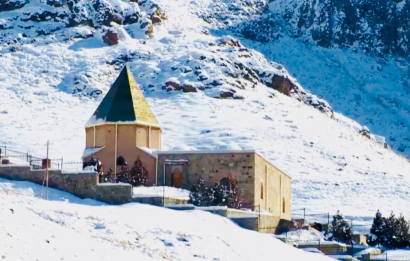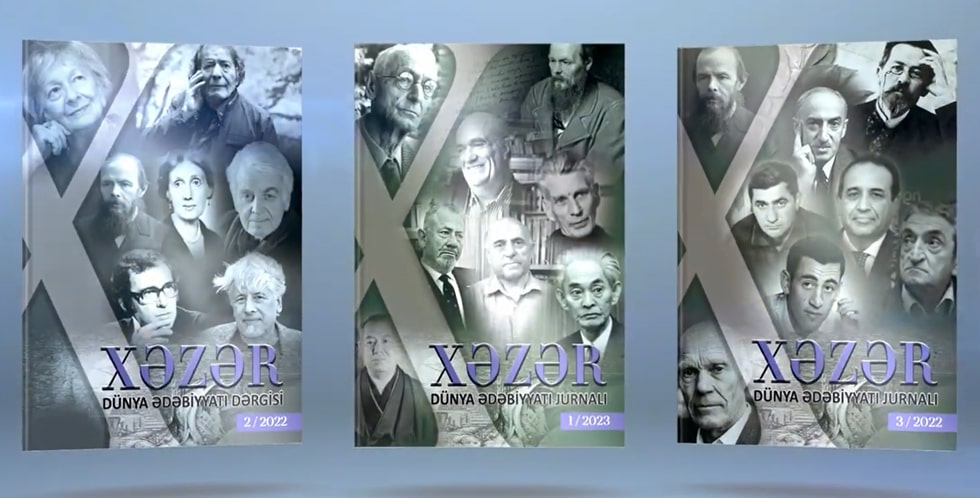Khanagah of Alinjachay

According to scientists, the history of Alinjachay Khanagah dates back to the VIII century. But it is a hypothesis because during the restoration activities in the Khanagah, the majority of stone manuscripts found there belonged to the XIV-XV centuries, after Fazlullah Naimi's execution in 1401 at the order of Miran shah near the Alinja River.
It is said that after Fazlullah's tragic execution, his adherents gathered together the parts of his body and buried there. They erected a tomb over Naimi's grave. As it is said, the most influential Sufi sheikh at the Khanagah went to Amir Teymur's place and asked for permission to bury Fazlullah.
According to another legend it is said that after Fazlullah's execution his followers in secret gathered the parts of his body, took to Khanagah and buried there. But Teymur's soldiers made inquiries about it blocking their road. When they asked 'Who is that? Where are you taking him?', the adherents said: 'Sheikh Khorasani.' That time, as Khorasan was the centre of science and irfan, the soldiers let them pass. Therefore, the second name of the Khanagah was 'Sheikh Khorasani.'
As Naimi's followers buried him in that area, Khanagah became a sacred place for people. Some scientists claim that Naimi wasn't buried there. But during the archaeological researches a burial monument and 3 stone pieces that belonged to Naimi were found. Nasimi's ghazal 'Efendim'devoted to Naimi was engraved on those stones. The symbols of Hurifism - one of the branches of Sufism, described in the ghazal, such as 'The Sun of Religious', 'Flowers of the Pomegranate Buds' and the poetic description of the place where Naimi had been executed were engraved on the stones as well.
The Khanagah was built on the basis of the mathematical calculations given in 'Javidanname.' That mosque was built by Khanbika Khatun, one of Fazlullah's adherents, Lala Malik's daughter. The date is the XV century. In order to speak about the Sufi symbols and figures in Khanagah we should take 'Javidanname' and relying on it we can advance an idea, as these facts are enough deep issues. Certain figures - as the expression of Hurufi logic through figures - on the found stones are astonishing. Some samples from 'Javidanname' - concrete images/descriptions of an angle of 360 degree , year, month and days from astrological point of view, period of motion of the Sun's rays, etc. are reflected on the stones. There are images of the Sun on the right and left sides of the stone manuscripts erected in memory of Khanbika Khatun, and within the Sun's figures there were described 24 triangles. The lines engraved in these triangles symbolize the Sun's rays. While reading the book 'Javidanname ' and analysing it, you understand that Hurufism was explained in a very plain language. Only the human features, figures of 32 and 28 of the Arabic alphabet are introduced as the symbols of Hurufism. If we are satisfied with this information about Hurufism, then we won't be able to learn more about this great science. All 'digital secrets' of Hurufism are collected in 'Javidanname.' There exist astonishing difficult and exact calculations in the book. Frequently used figures in Hurufism are 1, 2, 6, 7, 11, 17.
If the figure 32 is found only once in the book, the figures 1, 2 and 6 can be found in all the parts of the book. Here the figure 1 refers to God. According to Hurufism God can't be expressed by any symbol. It could only be linked with letters or felt through divine light in dream. It is observed in some ghazals of Nasimi. The figure 2 notes that God created everything in pairs. As everything in the world is taught through contradistinction: body-spirit, night-day... good-bad, etc.
Elmin NURI
AND OTHER...
-
 Isi Malikzade’s Creativity on German Literature Magazine
Isi Malikzade’s Creativity on German Literature Magazine
LESERING.de, a popular German e-literature magazine, has posted in German the short story Salt by Isi Malikzade, the notable Azerbaijani writer, as part of the AzSTC project “Azerbaijan Literature in an International Virtual World”.
-
 Movlud Movlud’s Short Story on Turkish Portals
Movlud Movlud’s Short Story on Turkish Portals
“Detayhaberler.com”, “Dibace.net” and “Haber.232.com”, leading Turkish portals, have posted in Turkish the short story “We Have Already Grown Up” by the...
-
 The Book “The Classification of Words Extracted from “The Spelling Dictionary of the Azerbaijani Language” Out
The Book “The Classification of Words Extracted from “The Spelling Dictionary of the Azerbaijani Language” Out
The Azerbaijan State Translation Centre has published a voluminous book “The Classification of Words Extracted from “The Spelling Dictionary of the Azerbaijani Language”









